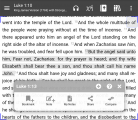| « Marketplace Coverage Affordability Worksheet | Don't Forget These ACA Exemptions » |
Education Credits: Quirks and Questions
In many cases claiming the education credit for clients is relatively easy. If there are only taxpayer expenses, you only need to determine the amount of qualifying expenses (QE). In many cases that is reported on the 1098T. Add required expenses paid elsewhere and the rest is math. It becomes just a little more difficult if scholarships are involved. In those cases you need to determine the amount of QE and coordinate that with scholarships. Normally scholarships offset QE and you would take the difference. In some cases you may be able to increase QE by including scholarship amounts in income. If some amount of scholarship covered expenses is included in QE you simply need to remember to include that amount in taxable scholarships.
Financial Records
The biggest issue related to claiming education credits is acquiring records for education expenses. It’s true that the 1098T can provide information you can use to calculate the credit, but those situations are limited to 1098Ts that list amounts paid in box 1, and do not have a check in box 7. In many cases the 1098T doesn’t provide enough information. If box 2 is used instead of box 1, you need to verify that billed amounts were actually. That’s not a big issue, but if box 7 is checked, even more research is necessary. If box 7 is checked there are amounts in box 2 that cover the following year and may likely not be paid in the tax year. Also, if box 7 is checked it is likely that the previous year includes amounts billed in the previous year (not the tax year) and that are paid in the tax year of the return.
While institutions provide better access to student financial records, some are not easily attained. The local university, for example, can show the amounts paid but the software doesn’t support printing a complete list of transactions unless they are visible on screen. The most difficult situations are where the scholarships cover expenses and the institution does not provide students with the 1098T.
Scholarships
There are some quirks you should be aware of when preparing returns with education credits. One of those quirks involves coordinating returns of the taxpayer and student. If the taxpayer claims an education credit based on including scholarships in income, it is the student (not the taxpayer) that must include the scholarship in his income. The paid expenses can be moved back and forth, but the scholarships can’t. Like many situations when the parent may or may not claim a child, the returns should be coordinated for the most benefit. In those cases, visiting the preparer should be a family affair.
Changes in EITC
One of the characteristics of taxable scholarships is that it is not earned income for purposes of the EITC. You can’t increase EITC by including scholarships in income. Those scholarships are included in line 7, but failing to tag that amount in the margin as SCH could lead the IRS to believe you understated income and make corrections to EITC.
Although scholarships are not earned income for EITC it can affect it negatively. EITC is initially calculated on earned income in the worksheet, but it is then calculated based on AGI. The lower credit amount is what the taxpayer receives. The net benefit of including the scholarships should always be considered. In your software, you may be able to incrementally include scholarship income and increase QE to determine at what point the income reduces the net benefit. Then you can use that amount to calculate the credit.
Measured Scholarships
There is no regulation that addresses scholarships that are measured by the amount of tuition, as opposed to “must be used for” tuition. While that may seem to be simply semantics, a change in the wording was the defining characteristic that allowed scholarship inclusion in the Louisiana TOPS program. In that program the amount of the scholarship is limited to the amount of tuition, and the IRS has determined that this scholarship qualifies to be included in income to increase QE for education credits.[1] As a PLR it can’t be cited in court, but the logic of the ruling can obviously be used. Following the ruling, the Louisiana Law Review published an article encouraging recipients of the TOPS grant to consider using Treasury Reg. 1.25A-5 to amend their returns to claim education credits.[2]
A similar program is the TEXAS Grant that is limited to an amount equal to tuition costs. As such, it would likely be considered eligible for the same treatment. The promotional website contains the following
The maximum award amount (including state and institutional funds) is equal to the student's tuition and required fees.
That wording and the lack of related restrictions in the supporting regulation suggests that you can include it in income in order to increase education credits. For more conservative paid preparers, you can include Form 8275 with the taxpayer's return explaining this treatment.
Refer to excerpts from PLR 200137006 below.
4. Federal tax consequences of the Louisiana TOPS Award under §§ 25A and 117.
As noted earlier, prior to being amended in 1999, Louisiana law required that awards made to students under the TOPS program be spent on tuition. As such, the amount of any award was excludable from gross income under § 117 and reduced the amount of qualified expenses eligible for the education tax credit. However, in 1999, the Louisiana legislature amended the TOPS statute for the express purpose of qualifying a student or his parent or guardian for the § 25A credit. The legislature amended the TOPS statute to –
(1) provide that TOPS awards are in an amount equal to tuition (rather than being for tuition);
(2) cause the administering agency to direct the institution that whenever the TOPS award is paid on behalf of the student and the student’s tuition is paid from a source other than the TOPS award, the award is to be applied by the educational institution toward payment of those "costs of attendance" other than tuition; and
(3) permit a student to elect to defer receipt of a TOPS award and to spend the amount received on costs of attendance other than tuition and provide that the amount of the award will be reduced if a § 25A credit is claimed.
..
We view these statutory provisions as terms of the grant and discuss below the effect the Service should give these terms in applying §§ 25A and 117 to award recipients.
..
Under the terms of the grant as we construe them, therefore, the Service should give effect to Louisiana’s changes under (1), above, which permit the award to be used for either qualifying or non-qualifying expenses. Under this interpretation, the exclusion of the grant is determined by the tax reporting of the grantee.
Questions
There are also some unanswered questions related to education credits. Here’s a few I’ve come up with.
Books purchased by a third party (not at institution)
The regulations say that an amount paid to the institution by a third party is considered an amount paid by the taxpayer. The taxpayer can also include expenses paid for required books and supplies even though they are not paid to the institution. But, what about amounts paid by a third party for required books purchased outside of the institution? Are those also considered paid by the taxpayer?
Excess + Elective limited to Elective
Excess scholarships must be included in income, and elective (aka unrestricted) scholarships can be included in income to increase qualifying expenses. What happens if the total amount of excess and elective is greater than the amount of elective scholarships? Is that a limitation?
This last scenario in my article on Education Credits in TaxWise has the scenario where the credit is maximized if $5,280 is included in income. Since the Pell grant was $5,250, is the taxpayer limited to including that amount in income? The excess amount of scholarships is $2,000 so the taxpayer is required to include that amount. Since it's required, not an elective, it is not a case where the taxpayer is choosing to include in income. Does that amount represent an excess from all scholarships or from unrestricted scholarships first? In the later case there would be a $5,250 limitation.
This may not happen often, but it is something to consider. That extra $30 only equates to a $7.50 credit, and only $3 is refundable, so it may be more conservative to assume that limitation.
Rulings: How the IRS might rule? How the Tax Court might rule?
Professional Conservatism is a valuable tool for protecting the liability of practitioners. While it is possible to make many arguments for their clients, it is often much safer to be conservative. In that case, consider how the IRS might rule is such situations and how the Tax Court might rule. I've found that most Tax Court rulings are clear once you know the tax law related to each aspect of the case.
Amending for Education Credits
I’ve often advised taxpayers that they can amend their tax returns for up to three years from the due date. The part of the IRC related to amended returns, however, is more complex and confusing than you might expect. In section 6511(b)(2)(A), for example, we can read limits on the amounts of an amended return.
(A) Limit where claim filed within 3-year period
If the claim was filed by the taxpayer during the 3-year period prescribed in subsection (a), the amount of the credit or refund shall not exceed the portion of the tax paid within the period, immediately preceding the filing of the claim, equal to 3 years plus the period of any extension of time for filing the return. If the tax was required to be paid by means of a stamp, the amount of the credit or refund shall not exceed the portion of the tax paid within the 3 years immediately preceding the filing of the claim.
My reading of the code suggests that the taxpayer can’t receive more refund than he paid in taxes during the look-back period (statute of limitations). One instance where this would be relevant is when the taxpayer owes taxes during one of the three years. That would make sense when referring to taxes withheld. However, it might be argued that this section says taxpayers are not allowed refundable credits with amended returns since they do not represent a reduction in taxes already paid. Court cases have dealt with the questions related to this section of the code, but they have primarily dealt with time limitations.
Concerning education credits, there is a notice, however, that alters the originally proposed education credit regulations, which would have restricted the credits to those claimed on a timely filed return. Notice 99-32 provided that taxpayer may amend their returns to claim education credits.[3] Likewise, sections in the Internal Revenue Manual instruct IRS staff to advise taxpayers to amend their return for such refundable credits. Section 6511 is one of many IRS code sections that need to be clarified, but it isn’t one to be concerned about in relation to education credits.

